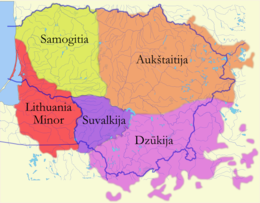
Back Lituania Menor AN ليتوانيا الصغرى Arabic Kiçik Litva Azerbaijani Mažuojė Lietova BAT-SMG Малая Літва Byelorussian Малая Летува BE-X-OLD Lituània Menor Catalan Malá Litva Czech Lille Litauen Danish Preußisch Litauen German
This article needs additional citations for verification. (April 2023) |
Lithuania Minor
Mažoji Lietuva | |
|---|---|
| |
 Location of part of Lithuania Minor within modern Lithuania | |
| Countries | Lithuania, Russia |
| Capital | Tilžė (Tilsit) |
| Largest city | Klaipėda |
| Area | |
• Total | 2,848 km2 (1,100 sq mi) |
| area on the right-bank of the Neman river (Klaipėda Region), excluding Kaliningrad Oblast side | |
| Population (1925)[1] | |
• Total | 141,650 |
| • Density | 50/km2 (130/sq mi) |
| population on the right-bank of the Neman river (Klaipėda Region), excluding Kaliningrad Oblast side | |
| Time zone | UTC2 (CET (GMT +2)) |

Lithuania Minor (Lithuanian: Mažoji Lietuva; Polish: Litwa Mniejsza; German: Kleinlitauen) or Prussian Lithuania (Lithuanian: Prūsų Lietuva; Polish: Litwa Pruska; German: Preußisch-Litauen) is a historical ethnographic region of Prussia, where Prussian Lithuanians (or Lietuvininkai) lived, now located in Lithuania and the Kaliningrad Oblast of Russia. Lithuania Minor encompassed the northeastern part of the region and got its name from the territory's substantial Lithuanian-speaking population. Prior to the invasion of the Teutonic Knights in the 13th century, the main part of the territory later known as Lithuania Minor was inhabited by the tribes of Skalvians and Nadruvians. The land depopulated during the incessant war between Lithuania and the Teutonic Order. The war ended with the Treaty of Melno and the land was repopulated by Lithuanian newcomers, returning refugees, and the remaining indigenous Baltic peoples; the term Lithuania Minor appeared for the first time between 1517 and 1526.
With the exception of the Klaipėda Region, which became a mandated territory of the League of Nations in 1920 by the Treaty of Versailles and was unified with Lithuania from 1923 to 1939, the area was part of Prussia until 1945, which at various times was under sovereignty of the Kingdom of Poland, the Polish–Lithuanian Commonwealth and Germany. Since 1945, a small portion of Lithuania Minor has been retained within the borders of modern-day Lithuania and Poland while most of the territory is part of the Kaliningrad Oblast of Russia, which was part of the Soviet Union until December 1991.
Although hardly anything remains of the original culture due to the expulsion of Germans after World War II, Lithuania Minor has contributed significantly to Lithuanian culture overall. The standard written form of Prussian-Lithuanian provided the basis for modern Lithuanian,[2] evolved from people close to Stanislovas Rapalionis and graduates from Lithuanian-language schools established in Vilnius, who were expelled from the Grand Duchy during Counter-Reformation years. Those include notable names like Abraomas Kulvietis and Martynas Mažvydas. During the years of the 19th-century Lithuanian press ban, most of the Lithuanian books printed using the Latin alphabet were published in Lithuania Minor.
- ^ a b "Klaipėdos kraštas".
- ^ (in German) [1]







